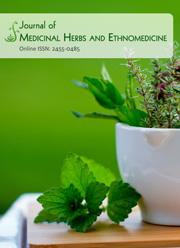Antioxidant potentials of the extracts from 14 selected medicinal plants
Antioxidant capacity and importance
DOI:
https://doi.org/10.25081/jmhe.2020.v6.6060Keywords:
Antioxidant, DPPH, extract, lipid peroxidation, plants, superoxideAbstract
Most of the medicinal plants possess interesting antioxidant properties. The present study aimed to evaluate the antioxidant capacity of some medicinal plants from Turkey, such as Anthemis tinctoria L. (Compositae), Inula britannica L. (Compositae), Malabaila secacul Banks & Sol (Apiaceae), Zosima absinthifolia (Vent) Link (Apiaceae), Thymus sipyleus Boiss. (Lamiaceae), Phlomis armeniaca Willd. (Lamiaceae), Sideritis galatica Bornm. (Lamiaceae), Sedum acre L. (Crassulaceae), Potentilla erecta Uspenski ex Ledeb. (Rosaceae), Digitalis lamarckii Ivan (Scrophulariaceae), Glaucium grandiflorum Boiss. & Huet var. grandiflorum (Papaveraceae), Fumaria asepala Boiss. (Papaveraceae), Centranthus longiflorus Stev. (Valerianaceae), Allium rotundum L. (Amaryllidaceae). The ethyl acetate and methanol extracts of the 14 species were screened by using 2,2-diphenyl-1-picrylhydrazyl (DPPH) radical scavenging, superoxide anion (SO) radical scavenging, and lipid peroxidation (LPO) assays. The methanol and ethyl acetate extracts of Potentilla erecta have the highest DPPH scavenging activity (IC50=0.014 and 0.03 mg/mL, respectively). The maximum inhibition of LPO has been exhibited by ethyl acetate extract of Glaucium grandiflorum var. grandiflorum (IC50=0.34 mg/mL) followed by methanol extracts of T. sipyleus (IC50=0.38 mg/mL). The methanol extract of A. rotundum demonstrated the highest SO activity (IC50=0.11 mg/mL). In conclusion, these extracts have a high potential for antioxidant activity may be considered to use free radical-related diseases.
Downloads
References
1. Halliwell B, Gutteridge J., Aruoma OI. The deoxyribose method: A simple test tube assay for determination of rate constants for reaction of hydroxyl radicals. Analytical Biochemistry. 1987; 165:215-219.
2. Lee SE, Hwang HJ, Ha JS, Jeong HS, Kim JH. Screening of medicinal plant extracts for antioxidant activity. Life Sciences. 2003; 30(73):167-79.
3. Wong SP, Leong LP, Koh JHW. Antioxidant activities of aqueous extracts of selected plants. Food Chemistry. 2006; 99:775-783.
4. Fatima I, Hussain T, Rafay M, Akram M, Bano S, Shabbir S. Evaluation of antioxidant activity of leaves and fruits extracts of five medicinal plants. Pakistan Journa? of Pharmaceutical Sciences. 2017; 30:1625-1628.
5. Perera HDSM, Samarasekera JKRR, Handunnetti SM, Weerasena OVDSJ, Weeratunga HD, Jabeen A, Choudhary MI. In vitro pro-inflammatory enzyme inhibition and anti-oxidant potential of selected Sri Lankan medicinal plants. BMC Complementary and Alternative Medicine. 2018; 3(18):271.
6. Xu DP, Li Y, Meng X, Zhou T, Zhou Y, Zheng J, Zhang JJ, Li HB. Natural antioxidants in foods and medicinal plants: Extraction, assessment and resources. International Journal of Molecular Sciences. 2017; 18(96):1-32.
7. Loffredo L, Perri L, Nocella C, Violi F. Antioxidant and antiplatelet activity by polyphenol-rich nutrients: focus on extra virgin olive oil and cocoa. British Journal of Clinical Pharmacology. 2017; 83:96-102.
8. Skrovankova S, Sumczynski D, Mlcek J, Jurikova T, Sochor J. Bioactive compounds and antioxidant activity in different types of berries. International Journal of Molecular Sciences. 2015; 16:24673-24706.
9. Krishnaiah D, Sarbatly R, Nithyanan R. A Review of the antioxidant potential of medicinal plant species. Food and Bioproducts Processing. 2011; 89:217-233.
10. Parejo I, Viladomat F, Bastida J, Rosas-Romero A, Saavedra G, Murcia MA, Jiménez AM, Codina C. Investigation of Bolivian plant extracts for their radical scavenging activity and antioxidant activity. Life Sciences. 2003; 15(73):1667-1681.
11. Almeida MMB, Sousa PHM, Arriaga AMC, Prado GM, Magalhães CEC, Maia GA, Lemos TLG. Bioactive compounds and antioxidant activity of fresh fruits from Northeastern Brazil. Food Research International. 2011; 44:2155-2159.
12. Singh HP, Kaur S, Negi K, Kumari S, Saini V, Batish DR, Kohli RK. Assessment of in vitro antioxidant activity of essential oil of Eucalyptus citriodora (lemon-scented Eucalypt; Myrtaceae) and its major constituents. Food Science and Technology. 2012; 48:237-241.
13. Blois MS. Antioxidant determination by the use of stable free radical. Nature. 1958; 181;1199-1200.
14. Mccord JM, Fridovich I. Superoxide dismutase. An enzymic function for erythrocuprein (Hemocuprein). Journal of Biological Chemistry. 1969; 244:6049-6055.
15. Mihara M, Uchiyama M, Fukuzawa K. Thiobarbituric acid value on fresh homogenate of rat as a parameter of lipid peroxidation in aging, CCl4 intoxication, and vitamin E deficiency. Biochemia Medica. 1980; 23:302-311.



 .
. 